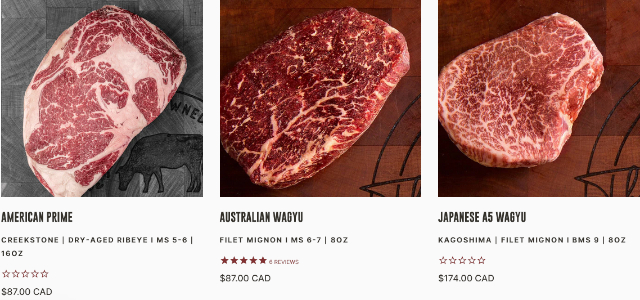I thought we, as a culinary society, were over the whole pretentious Wagyu Beef thing when COVID came in. It quickly eclipsed other, lesser health and wellness – and frivolous foodie – issues in the mass mind. But the Wagyu debate has surfaced again…
 A Tale of Three Wagyus… c/o The Meatery, San Diego, Cali.
A Tale of Three Wagyus… c/o The Meatery, San Diego, Cali.
I refer specifically to the debate over which (if any) version of Wagyu is superior to all others. And while the answer to that question may seem agonizingly obvious, aficionados insist on arguing the tiniest of fine points. I suppose they feel they must: we’re talking a world where one small steak can cost $600. and the difference between real deal Japanese Wagyu and Australian and American versions may mean a difference of hundreds of dollars.
Fat content
The first consideration for most self-proclaimed Wagyu ‘experts’ is almost always fat content and distribution – commonly called marbelling. As we’ll see below, the charachter of the marbelling may be more important to Wagyu hair-splitters than the overall fat content. But it’s one of the main variables in the official Japanese definition of Wagyu grades.
Flavour
For me, the flavour difference – such as it may be – would come first in any debate over Wagyu I was forced to engage in.
One foodie reviewer who was recently privileged to try all three types of Wagyu remarked: “I noticed a more pronounced beefiness and a refined balance in [Australian Wagyu’s] texture and taste, despite its inherently rich, fatty marbling. It eats more like how a steak should, even in the midst of its sumptuous and self-indulgent nature.”
The same critic said, of top-tier, A5 Japanese Wagyu: “The buttery richness of Japanese A5 Wagyu can be attributed to how Japanese Wagyu cattle are fed: Japanese Wagyu cows are fed for 600 days or more, whereas Australian Wagyu cows are fed for only 350 to 450 days. That longer feeding period means [a] larger, more fatty cow.” Nick Fiorentino, boss of San Diego, Cali., Wagyu shop The Meatery, said customers have told him that eating real Japanse Wagyu is, “like eating the richest dessert they’ve ever enjoyed in steak form.”
In said critic’s estimation American Wagyu didn’t even rate a director comparison to the other two contenders. After all, he pointed out, American Wagyu comes from a cross-bred cow variety while the Aus and Japanese versions both come from real Japanese Wagyu cattle, just raised a little differently.
Texture
This characteristic of any cut of any kind of meat depends on how it’s cut and how it’s cooked. With Wagyu, I understand, any small differences may depend on the distribution and ‘grain’ of the marbelling, not just the flat fat content. Finer-grained marbelling (as found in the real-deal Japanese product) ensures a more tender mouthful.
My take
I have to call out the unnamed critic quoted above, who claimed the Australian Wagyu, “[E]ats more like how a steak should.” I guess any comparison of any food based on percieved, preferred or predicted subjective values must be suspect at best. I can, however, try to factor in an American’s (assumed) preference for steak with a fuller, bolder mouth feel experience, in evaluating the critic’s comment. Not to mention the American taste for overdone meat.
That comment, in turn, calls into the question the validity of any comparison of various versions of something like Wagyu beef – any except your own, should you have the opportunity to make a first-hand evaluation..
Taking a couple of steps back… What the Hell does it matter now, of all times in history, whether Japanese, Australian or American Wagyu – which has always been a premium, novelty food – is considered best by a tiny group of eccentrics at the top of the food and economic chains?
Don’t know about you, but I haven’t consumed a steak for several years, now, and cannot foresee a time in the future when I will be able to afford the indulgence again. Let alone EVER having the chance to try Wagyu.
All of which makes me wonder if the era of the Unnamed Critic who got me started on this post has not passed into history, as well?
Muse on that!
~ Maggie J.

